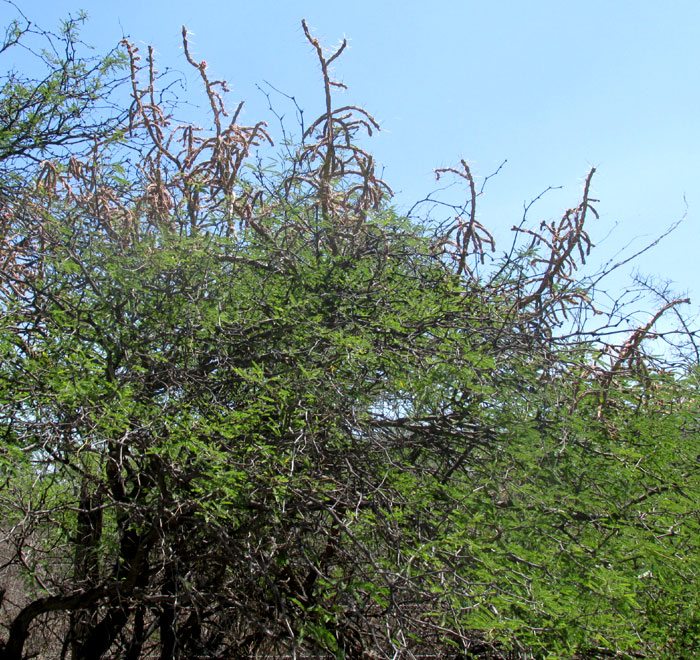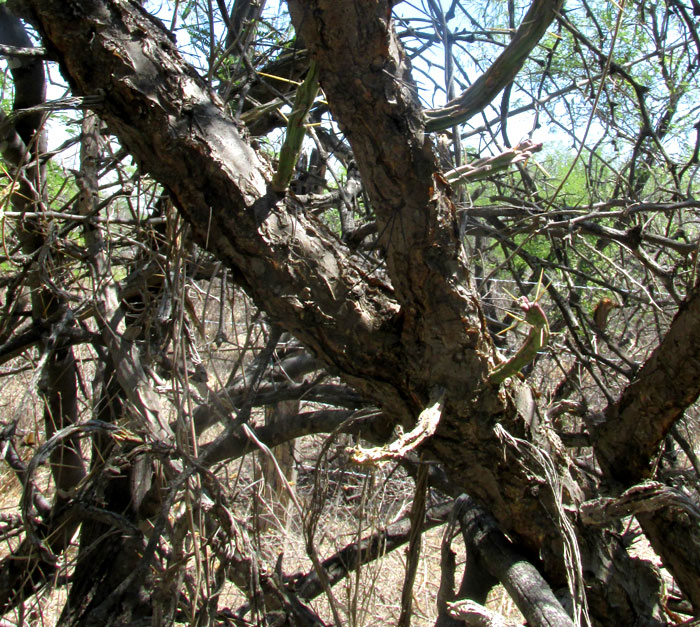Excerpts from Jim Conrad's
Naturalist Newsletter
entry dated April 28, 2023, issued from near Tequisquiapan, elevation about 1,900m (6200 ft), Querétaro state, MÉXICO
(~N20.55°, ~W99.89°)
KLEIN'S PENCIL CACTUS

The above caught my eye simply because it was a slender pencil cactus, genus Cylindropuntia, emerging from the top of a Smooth Mesquite tree. It's not uncommon to see pencil cacti in this area, in English often referred to by their Spanish name, Tasajillos, but I'd never seen a Tasajillo emerging from the top of such a large tree. The cactus's topmost branches bore what appeared to bear old fruits:

Inside the mesquite, the cactus's branching stems were thick and woody, bearing slender side-branches:

Also sheltering inside the mesquite, certain stems bore yellow and red items that presumably were old fruits:

At the tip of the above yellow item, notice the black, star-shaped opening. I think that the scar left by the ovary's fallen-off corolla, and the red one should have a similar one. Both items are so shriveled that they've lost their fruit shape. Notice that several features are branching off the main stem cutting across the image diagonally. Branches at the picture's lower, left appear to be stem branches, the reddish ones seem intermediate between being stem and old fruit.

Some stems bore yellowish growth like the three fuzzy, bumpy items seen above sprouting numerous tiny spines called glochids. These must be the beginnings of flower buds, with each pinkish bump emerging from the fuzzy yellowness being a future tubercle on a fruit. In the larger bud occupying the image's center, the flower's corolla should emerge from the bottom, where glochids are missing.
What do we have here? I'm sure it's a member of the cholla/pencil cactus genus Cylindropuntia. There's no treatment available for that genus in our region. The online, tourist-oriented website La Ruta de los Cactus, Querétaro, whose producer isn't clearly stated, but who appears to be well informed, lists four Cylindropuntia species for our immediate area here in Querétaro state, at the semiarid, western-facing base of the Eastern Sierra Madre Mountains.
Of the four candidate species, Cylindropuntia tunicata is very densely mantled with white spines. The other three taxa of Cylindropuntia, the species imbricata (Tree Cholla), kleiniae and leptocaulis (Tasajillo), are very similar. All three species occur in the US desert southwest south to southern Mexico north of the Isthmus of Tehuantepec. The Flora of North America mentions hybrids forming between C. kleiniae and both C. leptocaulis and C. imbricata. This raises suspicions that the three taxa may be better understood as a "poorly understood species complex," or even just one variable species on the verge, in evolutionary time, of forming new species. In fact, the Flora of North America suggests that "Cylindropuntia kleiniae itself may be of hybrid origin," meaning a hybrid between C. leptocaulis and C. imbricata.
And yet, I was drawn to the cactus shown above because, despite my long familiarity with both C. leptocaulis and C. imbricata, I'd never seen a member of that complex of taxa rising out of a tree like that.
On the basis of our cactus's outermost stems being less than 1.4cm across (½ inch), and thus not C. imbricata, and the stems' surfaces more clearly wrinkling into short, elongate wrinkles, or tubercles, than normal for C. leptocaulis, and its general un-Tasajillo-like behavior, I'm calling this CYLINDROPUNTIA KLEINIAE.
Cylindropuntia kleiniae, sometimes is referred to as Klein's Pencil Cactus
In the literature there's not much said about Cylindropuntia kleiniae, maybe because it's noticed less than the other two taxa of the complex, and/or is of less frequent occurrence.